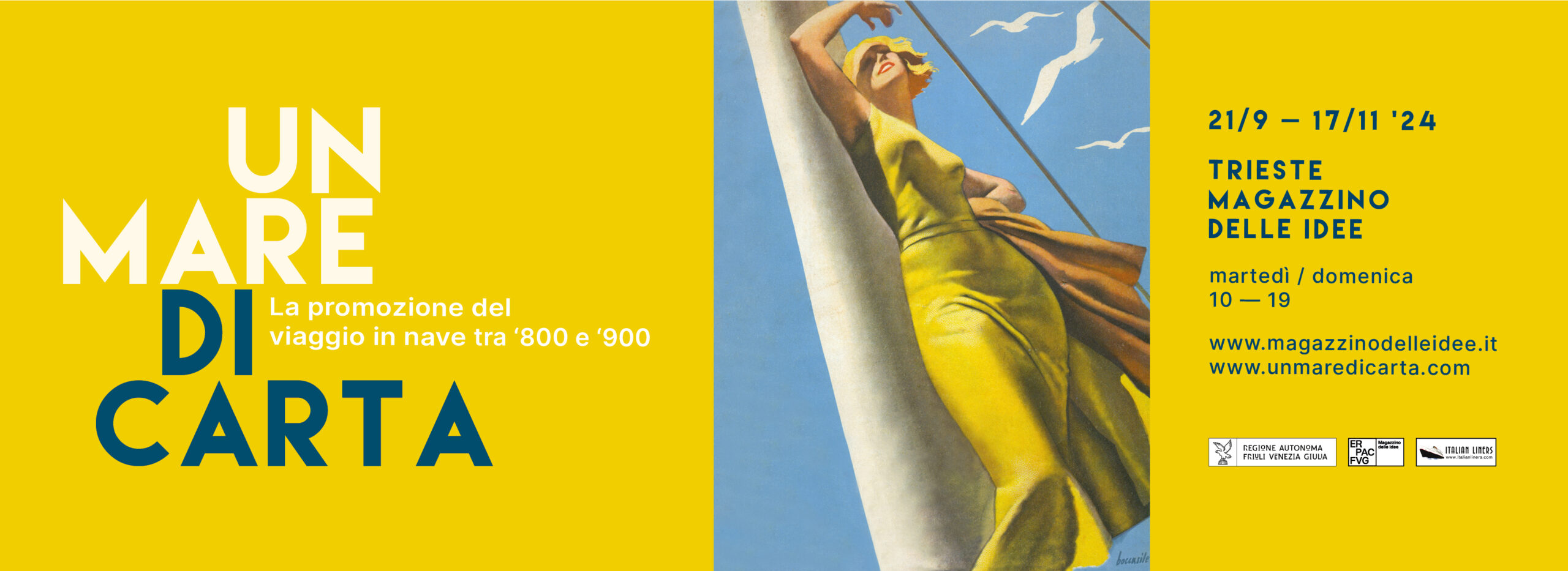The promotion of ship travel between the 19th and 20th centuries

20 September to 17 November 2024
Approximately three hundred posters and playbills, leaflets, brochures, sketches and commemorative publications unearthed from the archives and brought together in a single exhibition, designed to retrace, thanks to rare period materials, the evolution over a century, from the 1860s, of advertising graphics created in the 19th century to promote sea travel. A Sea of Paper. The promotion of sea travel between the 19th and 20th centuries (unmaredicarta.com), will open on Friday 20 September at 6pm at the Magazzino delle Idee. Realised by ERPAC FVG with the collaboration of the cultural association Italian Liners, the exhibition is dedicated to Angelo Battistella, one of the most prolific and brilliant graphic designers of the 20th century. Translated with DeepL.com (free version)
The exhibitions
The exhibition is based on a significant selection from the 25,000 documents from the ‘advertising graphics’ section kept in the archives of the Italian Liners association, with some additional contributions from private collections in Trieste. Curated by naval historian Maurizio Eliseo with the contribution of Sergio Vatta, it recounts the golden age of sea transport, eventually supplanted by air transport, but also of a host of graphic designers and illustrators, later replaced by skilled photographers. This era was the result of the Industrial Revolution, which radically changed sea travel as well as printing techniques: on the one hand, the great steamships were born, which, thanks to mechanical propulsion, freed water transport from winds and currents; on the other hand, systems for high print runs and for the reproduction of colour images were introduced, which led to the birth of large printing houses and new professional figures, designers, composers and graphic artists who had to effectively convey the promotional message with their images. Promotional graphics thus became an art, and the ocean liner, the largest, most majestic and complex self-propelled object ever conceived by man, was one of its favourite subjects.
The press and steamships would share a rapid evolution, which in ‘A Sea of Paper’ is recounted through an introductory section and four macro time areas: from the dawn to the Great War, the 1920s, the 1930s and the post-World War II period, up to the decline of the liner.
In 1818, the first regular liner service with Venice was inaugurated in Trieste by the steamship Carolina. Within a few decades, the mechanically propelled ship would establish its supremacy and, in the mid 19th century, numerous steamship companies began to offer regular liner services. The exhibition opens with the first colour map of steamship lines along the Italian peninsula (1844) and one of the oldest surviving posters, announcing the 1874 departure of the steamship Columbus from Genoa to Latin America. The last poster in the itinerary dates back to 1965 and is dedicated to the entry into service of the last Italian ocean liners, the Michelangelo and Raffaello twins: here, for the first time, a photograph takes the place of a drawing, decreeing the end of an era.
In mostra si possono ammirare manifesti coloratissimi o in bianco e nero, geometrie futuriste e qualche riferimento alla bella époque: sono opere di alcuni dei disegnatori più celebri dell’epoca, dai triestini Giuseppe Miceu, Oscar Hermann Lamb, Argio Orel, Giuseppe Sigon, Marcello Dudovich ad altri artisti di chiara fama come Aurelio Craffonara, Ettore Mazzini e Giuseppe Riccobaldi, fino all’americano Victor Beals, coordinatore della grande campagna pubblicitaria dedicata ai transatlantici italiani e alla “rotta del sole”, che unisce il Mediterraneo al Nord America. Attraverso i manifesti e grazie ad accurati pannelli esplicativi, si può così seguire la storia delle più importanti navi di linea che solcarono i nostri mari e delle numerose compagnie di navigazione dell’epoca: dal Carolina al Thalia, prima “nave da crociera” inaugurata a Trieste nel 1907, dai primi colossi transatlantici italiani entrati in servizio negli anni Venti, come il Conte Rosso, alle motonavi Saturnia e Vulcania, costruite tra il 1925 e il 1928 a Monfalcone. E ancora, nel 1932, il Rex, entrato nel mito per la sua velocità e scelto da Fellini per la scena centrale del suo capolavoro Amarcord, e il Conte di Savoia, la nave “in stile Novecento” costruita a Trieste.
Tutti nomi celebri di navi che scomparvero nel turbine della guerra. Ma nei primi anni Cinquanta si riavvia la costruzione di nuovi e portentosi transatlantici, come il Giulio Cesare e l’Andrea Doria, che danno vita alla cosiddetta “Renaissance Fleet”. Un’epoca che si concluderà nel decennio successivo, con il battesimo degli ultimi “giganti del mare”: la Leonardo da Vinci del 1960, e le gemelle Michelangelo e Raffaello del 1965. Sono gli ultimi transatlantici italiani, bellissimi quanto inutili perché oramai il pubblico preferisce spostarsi in aereo: un decennio più tardi vengono posti in disarmo, decretando la fine di un’epoca. Con essi si chiude la stagione lunga un secolo della grafica pubblicitaria dedicata ai viaggi di linea. Ormai la fotografia a colori ha preso il sopravvento.
Opening
Tuesday to Sunday 10 a.m. to 7 p.m.
Mondays closed
Special opening
1st November 2024
Tickets
Full price € 8.00
Reduced price € 5.00
– 65 years and over
– children from 12 to 18 years of age
– students up to 26 years of age
– differently abled
Free of charge
– children up to 12 years of age
– group leaders (1 per group)
– visiting teachers with pupils/students (2 per group)
– one accompanying person per disabled person
– ICOM cardholders
– journalists with a regular membership card of the National Association of Journalists in service
– FVG card holders

Groups (min 10 persons – max 25 persons):
€5.00 each without guide
€4.00 each with guide (plus €50.00 for the guide)
The ticket office closes half an hour before
Information
email: info@magazzinodelleidee.it
phone +39 040 3774783
Social
Facebook: @magazzinoideetrieste
Instagram: @magazzinodelleidee
#magazzinodelleidee


